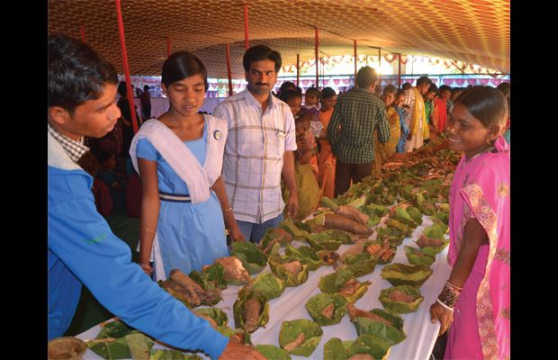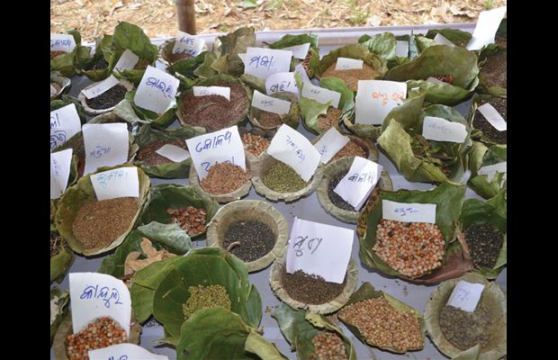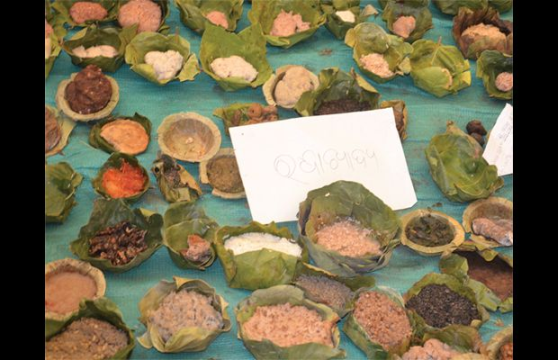
If I were to ask you to list the natural foods you eat, it would go somewhat like this. Wheat, rice, tomato, cucumber, apple, banana… you begin to reel out the names. Not many can go beyond 20. Try a little harder, and you will probably end up with another 10. Push yourself a little more, that number could go up to 35. That’s it.
That’s how limited our knowledge of natural foods is. Modern living has all but snapped our relationship with nature. How many of us know that there are over 51,000 plant species in India? The more urbanised we become, the less we know about the rich food culture that prevails in our country. This disconnect with the huge diversity of food has actually alienated modern civilisation from the virtues of the vast repository of biological wealth that exists around us.

Laxmi Pidikaka explained all this to me as she talked about the importance of each of the 1,582 food kinds that were on display. We were at Munda village in Odisha’s Rayagada district, some 400 km from capital Bhubaneswar. The village was hosting the Adivasi Food Festival, the first of its kind in the country. Laxmi, a tribal woman, was telling me something incredible. Of the 1,582 foods that lay before us — and that included different kinds of fish, crabs and birds that are part of the daily diet of some tribals — as many as 972 were uncultivated. Yes, you heard it right. Uncultivated foods!
A dozen tribes living in Odisha, Madhya Pradesh, Chhatisgarh, Jharkhand and Maharashtra had gathered at the Adivasi Food Festival to showcase various foods. It was a celebration of traditional food cultures linked to age-old farming practices that not only provide these tribes nutritional security, but also protects and conserves nature’s bounty. Members from the Kondh, Koya, Didai, Santhal, Juanga, Baiga, Bhil, Pahari Korva, Paudi Bhuiyan and Birhor from more than 300 villages spread across the tribal heartland had participated in the festival. Besides an appreciation of the different palates that were on offer, there was an overriding concern about how to protect traditional farming systems from the onslaught of the National Food Security Act that aimed at providing them with 5 kg of wheat, rice or millets.

“We don’t need your food security system,” said Minati Tuika of Katlipadar village. “The more ration shops you open in our villages, the more you force us to abandon our own food security system so painstakingly built by our forefathers.” This was strange, coming from someone who perfectly fit the bill of the typical underdeveloped tribal that policymakers had in mind while drafting the Act. In a larger sense, this was what we, the educated, have been thinking all along: that all efforts must be made to bring these underdeveloped tribals into the mainstream.
But, development, as I was to find out, is quite a different mental idea for these people. “Don’t teach us what development is,” said Minati. “We conserved and preserved our plants, our soil, our forests, and our rivers for centuries. Now you want to take these away, and destroy them. And then you call it development.” It took a little coaxing to get Minati to explain how the Adivasis were living in tandem with nature. She started by showing some plants.
The siali bean is a big-sized dry bean. Its seeds are consumed after boiling or roasting them. The branches are used to make ropes and the leaves to make leaf plates. Kusum koli leaves are used for fodder, its fruits eaten raw, the plant is used as firewood and oil is extracted from the seeds. The seed oil serves as a mosquito repellent and also treats certain skin diseases.
Even the less knowledgeable among us have heard of the mahua tree and its multiple uses. Its leaves are used for fodder and flowers used to make jaggery, liquor and porridge. Besides, the flowers are also consumed and often sold in the market. A kind of gravy is made from the fruit, which is also used as fodder and cooking oil is extracted from its seeds. All these are classified as uncultivated plants in agricultural parlance, and, therefore, do not receive any attention.
Debjeet Sarangi of Living Farms, which organised the one-day festival on 25 February, says the sole aim was to “deepen the communitarian ethos of the Adivasi society and shared knowledge systems”. The object was to highlight sustainable ways of growing food and their relationship with the Adivasis’ ecology — land, plants, animals and forests. Sarangi is bristled at the idea that this was a vain exercise, an attempt to romanticise a foregone practice. “That’s where we are wrong,” was his curt response. “These people are in complete harmony with their nature. Instead of brushing them aside as uncivilised, we have to learn from them. Whether we like it or not, the future of humanity is hidden in these tribal cultures.”
The range of the cooked foods on show substantiated Sarangi’s claim. The welcome drink served at the entrance, called mandia jau in the local language, was actually a gruel of ragi millets with a sprinkling of rice grains. “I don’t know why people need to drink colas and other kinds of sodas when you have such healthy drinks,” said Salome Yesudas, a Chennai-based nutritionist and one of the event’s organisers. Considering that the sale of colas has been on a decline, it would perhaps not be a bad idea to promote mandia jau.
In fact, healthy is a given in the preparation for the food, even for a diabetic like me. Most of these dishes, explained Yesudas, were based on different kinds of millets, which are the preferred food for people suffering from lifestyle diseases. Pancakes made from finger millet, foxtail millet with a little jaggery, cakes from ragi and sesame and then there were dishes using sorghum, pearl millet, kodo millet, barnyard millet, red rice with sprinklings of uncultivated fruits and seeds. The recipes were documented and a chart prepared, detailing the nutrition composition of uncultivated plants. There were also posters in English and Oriya on the vast variety of foods available for a balanced diet, as well as for the summer and winter seasons.
This was not the first traditional food festival I had visited. But, it was heartening to see some civil society groups trying to highlight the old, albeit ignored tradition, of tribal culinary habits. On another level, It also clearly demonstrated that what India needs is not a centralised food security system, but a multi-layered decentralised system based on the traditional practices of a particular region. Instead of providing tribals with a monthly entitlement of 5 kg of wheat or rice or millets, it would make better sense to strengthen existing food systems.
However, that policy cannot be driven home without a proper understanding of our traditional food systems and feeling a sense of pride in them. The richness of our food culture, which is so intricately linked to the preservation of natural resources, is where it can all begin.
I don’t know why our agricultural universities don’t talk about it; I don’t know why our food magazines and food shows never focus on traditional foods; and I am certainly not surprised why our Planning Commission has no idea as to what the tribal cultures imbibe.
First Published in Tehelka Magazine, Volume 11 Issue 11, Dated March 7, 2014
Photo Credits: Devendra Sharma (for more photos check online)